World on Film by Martha P. Nochimson

Author:Martha P. Nochimson
Language: eng
Format: epub
Publisher: Wiley
Published: 2011-09-04T16:00:00+00:00
The story of The Seven Samurai that leads to this dramatic moment is high action. A small farm community learns that a group of ronin bandits that has already attacked them once is planning to return when the barley harvest is ready. In desperation, the farmers send a delegation to town, where there are many samurai who are willing to sell their services, to hire some of them to protect the village. Common sense tells the farmers that this is a fool’s errand, as they have nothing but food with which to pay the samurai, who generally despise the farmers as an inferior class and are not likely to feel sympathy for them. However, the farmers meet up with a truly unusual ronin, Kambei, who is true to the code of Bushido; his code of honor prompts him to help them, and he assembles a crew of five other samurai plus the would-be warrior Kikuchiyo. Using a well-conceived strategy, based on the kind of planning only possible by warriors who hold to the highest standards, Kambei and the villagers save the town. Yet there is so much more to this film than thrills and chills.
In Figure. 5.9 we see one of the finest collaborations between director Kurosawa and actors Takashi Shimura and Toshiro Mifune. The contrast between the calm Kambei, embodied by Takashi Shimura, who shoulders the burden of this tragedy without losing control of the situation, and the intensity of Kikuchiyo, played by Toshiro Mifune, who is visibly distraught at the plight of the baby, symbolizes the integration of the best of past and present for which Kurosawa so passionately wished. Kambei’s poise in this terrible moment makes it possible for Kikuchiyo, born as a farmer but determined to be a samurai, to vent his raw emotions without endangering the fight being waged on behalf of the farmers. When Kikuchiyo says in this scene, “I am this baby,” Kambei is respectful when he learns that, as an infant, Kikuchiyo too was rescued from the destruction of war. The Seven Samurai, in the spirit of the influences from the American occupation, supports Kikuchiyo and mocks the feudal worldview that there can be no legitimate upward mobility. Here, the film visually speaks on behalf of Kikuchiyo’s ambition, as the burning waterwheel takes on a metaphoric dimension. The burning wheel evokes a modern vision of a full circle of Sengoku warfare in which a farmer’s son, Kikuchiyo, can mature into a warrior who saves another child as he was once saved.
In his commentary track on the DVD of The Seven Samurai, critic Stephen Prince notes the importance of the figure of the circle in this film, as an image of human completeness, harmony, and wholeness, Kurosawa’s principal ideals. The circle of the recurring seasons is a principal metaphor of farming life. The first time we see the farm villagers together, they form a circle as they agonize over the bandit army’s threat to their way of living. When the samurai arrive at the village to protect them, they create a banner in which they represent themselves as circles.
Download
This site does not store any files on its server. We only index and link to content provided by other sites. Please contact the content providers to delete copyright contents if any and email us, we'll remove relevant links or contents immediately.
The Kite Runner by Khaled Hosseini(5061)
Gerald's Game by Stephen King(4556)
Dialogue by Robert McKee(4306)
The Perils of Being Moderately Famous by Soha Ali Khan(4156)
The 101 Dalmatians by Dodie Smith(3440)
Story: Substance, Structure, Style and the Principles of Screenwriting by Robert McKee(3384)
The Pixar Touch by David A. Price(3345)
Confessions of a Video Vixen by Karrine Steffans(3230)
How Music Works by David Byrne(3157)
Fantastic Beasts: The Crimes of Grindelwald by J. K. Rowling(2977)
Harry Potter 4 - Harry Potter and The Goblet of Fire by J.K.Rowling(2974)
Slugfest by Reed Tucker(2923)
The Mental Game of Writing: How to Overcome Obstacles, Stay Creative and Productive, and Free Your Mind for Success by James Scott Bell(2836)
4 - Harry Potter and the Goblet of Fire by J.K. Rowling(2639)
Screenplay: The Foundations of Screenwriting by Syd Field(2561)
The Complete H. P. Lovecraft Reader by H.P. Lovecraft(2499)
Scandals of Classic Hollywood: Sex, Deviance, and Drama from the Golden Age of American Cinema by Anne Helen Petersen(2453)
Wildflower by Drew Barrymore(2431)
Robin by Dave Itzkoff(2369)
